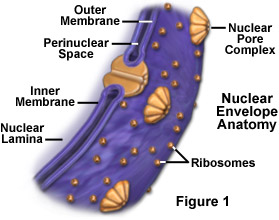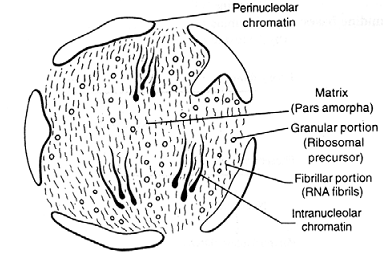Nucleus is a double membrane protoplasmic organelle which is present in all eukaryotic cells except mature sieve cells of vascular plants and red blood cells of mammals. Nucleus plays a very important role to regulate metabolic activities of the cell as well as also involved in the transmission of characters from one generation to another. Nucleus is a organelle which containg genetic material or genes which are responsible for all functioning of cell.
 Nucleus was first observed by Leeuwenhoek in red blood cells of fish, was first studied by Robert Brown (1831) in orchid root cells. A typical nucleus is absent in the prokaryotic cells instead of typical nucleus prokaryotic cells have their genetic material or nucleus without a nuclear membrane called nucleoid.
Nucleus was first observed by Leeuwenhoek in red blood cells of fish, was first studied by Robert Brown (1831) in orchid root cells. A typical nucleus is absent in the prokaryotic cells instead of typical nucleus prokaryotic cells have their genetic material or nucleus without a nuclear membrane called nucleoid.
Nucleus is usually centrally located in the cell and normally a cell will have one nucleus. But in some cases their number also vary like binucleated cells ( cell with two nucleus) e.g. Paramecium caudatum, multinucleated cells (cells with multiple number of nucleus) also called syncytial cells or coenocytic cells e.g. Rhizopus, Vaucheria.
Ultrastructure:- These are following components of nucleus which plays very important role in the functioning of nucleus:-
i) Nuclear Envelop:- A typical is always bounded by outer covering called nuclear envelop which separates the nucleus from cytoplasm. This nuclear envelop is made up of double membranes inner and outer membrane. These membranes are trilaminar and made up of lipoproteins. A perinuclear space is present between the two membranes. Inner membrane of nucleus is smooth but outer membrane because of presence of endoplasmic reticulum becomes rough. Nuclear envelop contains a large number of pores. Because nuclear membranes are immpermeable to large biomolecules these pores functions as a channels and create connection between cytoplasm and nucleoplasm (nuclear sap). In some cases 10% of the envelop is occupied by nuclear pores.
ii) Nucleoplasm:- It is a fluid present in the nucleus. This fluid is normally transparent, semifluid and containing colloidal substances. Nucleoplasm has number of the enzymes like DNA polymerase, RNA polymerase and nucleoside phosphorylases. These enzymes plays very important role in the various functions of nucleus.
iii) Nuclear matrix:- This is a network of fine fibrils of proteins that functions as scaffold for chromatin. Nuclear matrix is dense and making fibrous layer just below the nuclear envelop called nuclear lamina. Terminal ends of chromatin fibres embedded in this region of nucleus. It is also important because it provides mechanical strength to the nuclear envelop and also a attachment sites to telomeric sites.
 Sectional view of nuclear envelop
Sectional view of nuclear envelop
iv) Chromatin:- Chromatin is a complex of macromolecules which is names after its ability to get stained with certain basic dyes. Chromatin fibres are distributed throughout the nucleoplasm. They are differentiated into two regions - Euchromatin and heterochromatin. Euchromatin is usually light stained part which forms the bulk of the chromatin. The dark stained part is called heterochromatn. The whole chromatin is not functional but the portion of the euchromatin associated with the acid proteins takes part in transcription ( synthesis of RNA).
Nucleolus:- It is rounded, naked and slightly irregular structure which is attached to the chromatin at specific region called nucleolar organiser region. Because of the absence of covering membrane around it Ca ion are involved in the maintenance of configuration.
The size of the nucleolus is directly related to the synthetic activities of the cell.

Ultrastructure of Nucleolus
Nucleolus is the principal site for the development of ribosomal RNA. Therefor, it is the center of the formation of ribosomal components. It also plays role in the cell division.
Functions of Nucleus:-
i) It is very essential organelle of the cell because it contains genetic material in the form of DNA.
ii) It is the region which takes part in controlling all cellular activities.
iii) The DNA present in the nucleus is responsible for the passage of characters from one generation to next generation.
iv) Variation are also result of the changing in the genetic material or mutation are also the result of change on genetic material.
v) Ribosome precursors are also formed in the nucleolus which is the part of nucleus.
 Nucleus was first observed by Leeuwenhoek in red blood cells of fish, was first studied by Robert Brown (1831) in orchid root cells. A typical nucleus is absent in the prokaryotic cells instead of typical nucleus prokaryotic cells have their genetic material or nucleus without a nuclear membrane called nucleoid.
Nucleus was first observed by Leeuwenhoek in red blood cells of fish, was first studied by Robert Brown (1831) in orchid root cells. A typical nucleus is absent in the prokaryotic cells instead of typical nucleus prokaryotic cells have their genetic material or nucleus without a nuclear membrane called nucleoid. Nucleus is usually centrally located in the cell and normally a cell will have one nucleus. But in some cases their number also vary like binucleated cells ( cell with two nucleus) e.g. Paramecium caudatum, multinucleated cells (cells with multiple number of nucleus) also called syncytial cells or coenocytic cells e.g. Rhizopus, Vaucheria.
Ultrastructure:- These are following components of nucleus which plays very important role in the functioning of nucleus:-
i) Nuclear Envelop:- A typical is always bounded by outer covering called nuclear envelop which separates the nucleus from cytoplasm. This nuclear envelop is made up of double membranes inner and outer membrane. These membranes are trilaminar and made up of lipoproteins. A perinuclear space is present between the two membranes. Inner membrane of nucleus is smooth but outer membrane because of presence of endoplasmic reticulum becomes rough. Nuclear envelop contains a large number of pores. Because nuclear membranes are immpermeable to large biomolecules these pores functions as a channels and create connection between cytoplasm and nucleoplasm (nuclear sap). In some cases 10% of the envelop is occupied by nuclear pores.
ii) Nucleoplasm:- It is a fluid present in the nucleus. This fluid is normally transparent, semifluid and containing colloidal substances. Nucleoplasm has number of the enzymes like DNA polymerase, RNA polymerase and nucleoside phosphorylases. These enzymes plays very important role in the various functions of nucleus.
iii) Nuclear matrix:- This is a network of fine fibrils of proteins that functions as scaffold for chromatin. Nuclear matrix is dense and making fibrous layer just below the nuclear envelop called nuclear lamina. Terminal ends of chromatin fibres embedded in this region of nucleus. It is also important because it provides mechanical strength to the nuclear envelop and also a attachment sites to telomeric sites.

iv) Chromatin:- Chromatin is a complex of macromolecules which is names after its ability to get stained with certain basic dyes. Chromatin fibres are distributed throughout the nucleoplasm. They are differentiated into two regions - Euchromatin and heterochromatin. Euchromatin is usually light stained part which forms the bulk of the chromatin. The dark stained part is called heterochromatn. The whole chromatin is not functional but the portion of the euchromatin associated with the acid proteins takes part in transcription ( synthesis of RNA).
Nucleolus:- It is rounded, naked and slightly irregular structure which is attached to the chromatin at specific region called nucleolar organiser region. Because of the absence of covering membrane around it Ca ion are involved in the maintenance of configuration.
The size of the nucleolus is directly related to the synthetic activities of the cell.

Ultrastructure of Nucleolus
Nucleolus is the principal site for the development of ribosomal RNA. Therefor, it is the center of the formation of ribosomal components. It also plays role in the cell division.
Functions of Nucleus:-
i) It is very essential organelle of the cell because it contains genetic material in the form of DNA.
ii) It is the region which takes part in controlling all cellular activities.
iii) The DNA present in the nucleus is responsible for the passage of characters from one generation to next generation.
iv) Variation are also result of the changing in the genetic material or mutation are also the result of change on genetic material.
v) Ribosome precursors are also formed in the nucleolus which is the part of nucleus.
No comments:
Post a Comment